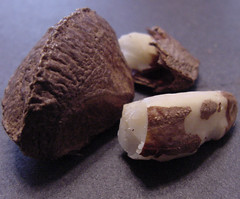I used to like to eat Brazil nuts, but these days I have to take three packets out of four back to the shop as they are not fit to eat. They never look nice and white like the one in the picture, but are off-white and translucent - the first sign that they are going bad.
Yet again today I have purchased a packet of Brazil nuts from my localhealth food store, Infinity Foods, only to find them rancid on opening them this evening. I had hoped to eat a few to finish my evening meal and am disappointed that I can't, and now have the nuisance of making a trip back to the shop - they are quite happy to give me my money back but this just shouldn't be happening. The previous bag I bought was mouldy through and through.
The sale of rancid or mouldy Brazil nuts is a new phenomenon. It has apparently followed the introduction of Directive 1525-98 which has effectively put an end to the sale of Brazil nuts in their shells.
The Brazil nut is the product of millions of years of evolution. The kernel has multiple wrapping, including the woody shell in which the nuts used to be sold, and the papery inner husk. This provides the best possible protection, and means that the kernel will normally remain in perfect condition for a considerable period, and remains fresh when the nut is finally cracked open to be eaten. If it was off or mouldy, this would be perfectly evident.
Occasionally, the nuts can be infected with a dangerous mould known as aflatoxin, and to reduce the hazard, the EC introduced Directive 1525-98, which in practice has meant that Brazil nuts are shelled and de-husked and then exported from their country of origin in sealed plastic sacks.
Unfortunately, once the shell and husk have been removed, the nut starts to deteriorate and go rancid. Worse still, if one nut in the sack is infected with mould, this will spread through the entire contents.
Thus the effect of the Directive is that the Brazil nuts on sale in the shops are rarely fresh and often rancid (they taste soapy) or mouldy, so that more people are put to more risk than if the nuts were left in their shells and the people who finally ate them did the checking for themselves, and even then, just the odd nut would be affected instead of a whole sackful.
In the light of this problem, the regulation needs to be reviewed and probably abolished.
Yet again today I have purchased a packet of Brazil nuts from my localhealth food store, Infinity Foods, only to find them rancid on opening them this evening. I had hoped to eat a few to finish my evening meal and am disappointed that I can't, and now have the nuisance of making a trip back to the shop - they are quite happy to give me my money back but this just shouldn't be happening. The previous bag I bought was mouldy through and through.
The sale of rancid or mouldy Brazil nuts is a new phenomenon. It has apparently followed the introduction of Directive 1525-98 which has effectively put an end to the sale of Brazil nuts in their shells.
The Brazil nut is the product of millions of years of evolution. The kernel has multiple wrapping, including the woody shell in which the nuts used to be sold, and the papery inner husk. This provides the best possible protection, and means that the kernel will normally remain in perfect condition for a considerable period, and remains fresh when the nut is finally cracked open to be eaten. If it was off or mouldy, this would be perfectly evident.
Occasionally, the nuts can be infected with a dangerous mould known as aflatoxin, and to reduce the hazard, the EC introduced Directive 1525-98, which in practice has meant that Brazil nuts are shelled and de-husked and then exported from their country of origin in sealed plastic sacks.
Unfortunately, once the shell and husk have been removed, the nut starts to deteriorate and go rancid. Worse still, if one nut in the sack is infected with mould, this will spread through the entire contents.
Thus the effect of the Directive is that the Brazil nuts on sale in the shops are rarely fresh and often rancid (they taste soapy) or mouldy, so that more people are put to more risk than if the nuts were left in their shells and the people who finally ate them did the checking for themselves, and even then, just the odd nut would be affected instead of a whole sackful.
In the light of this problem, the regulation needs to be reviewed and probably abolished.

Kommentarer